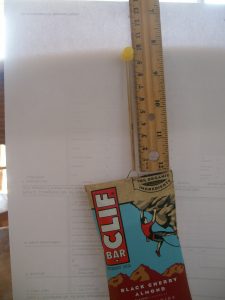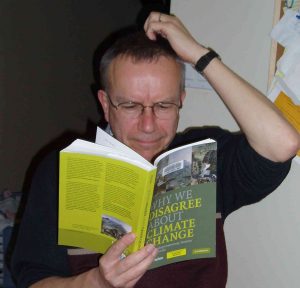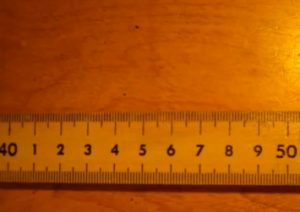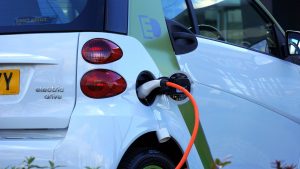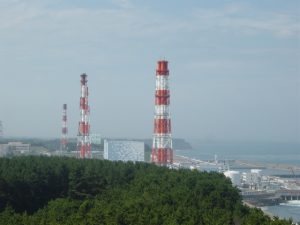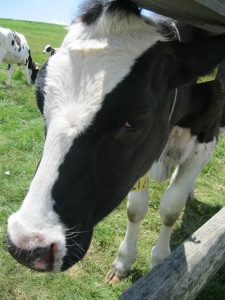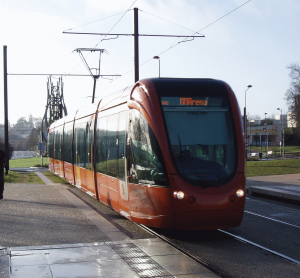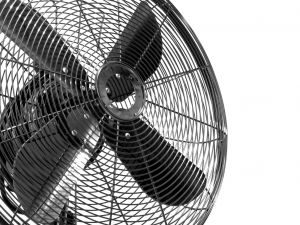Blood Pressure
Why do you feel dizzy if you stand up too quickly?
Themes: Biology & Medicine and Human Body
Topics: Biophysics, Fluids, and Pressure
Grades: 8-10
Stretching Rubber Bands
We can use common household objects to measure properties that match physical laws. This experiment takes a very common household item, the rubber band, and applies physical laws (Hooke’s Law and the Young’s Modulus) to them in a hands-on way.
Themes: Student Projects
Topics: Deformations, Experiments, Hooke's Law, Materials, and Young's Modulus
Grades: 11-12
Bats and the Doppler Shift
What compensation for Doppler shifts do bats perform to keep their echoes within their hearing range?
Themes: Animals, Biology & Medicine, and Waves
Topics: Biophysics and Sound
Grades: 11-12 and 8-10
Nerve Impulses
Why are eye-foot and eye-hand reaction times different?
Themes: Biology & Medicine and Human Body
Topics: Biophysics
Grades: 11-12 and 8-10
Wave Power – A Simple Analysis
How much power can we extract from ocean waves?
Themes: Energy and Environment and Renewable and Clean Energy
Topics: Energy and sustainability
Grades: 11-12
True, False, or Not Sure? Philosophy of Science in the 21st century
Whatever happened to objective reality? Why is anthropogenic climate change so hard to “prove”?
Topics: Climate, Energy, and Science Literacy
Grades: 11-12 and 8-10
Dimensional Analysis
Unsure if your result makes sense?
Themes: Skills and Techniques
Topics: Mathematics and Science Literacy
Grades: 8-10
Scientific Notation
“The suspect is a male, age 1.73 × 109 s, height 1.83 m, weight 7.5 × 101 kg…”
Themes: Skills and Techniques
Topics: Mathematics and Tools
Grades: 8-10
Order of Magnitude Calculations
How can we make reasonable approximations without tedious calculations?
Themes: Skills and Techniques
Topics: Mathematics, Science Literacy, and Tools
Grades: 8-10
Significant Figures
This tyrannosaurus is 70,000,003 years old. How many significant figures should I quote?
Themes: Skills and Techniques
Topics: Mathematics and Tools
Grades: 11-12 and 8-10
Energy and Greenhouse Gas (GHG) Calculations
How much Chemistry and Biology do you need to understand to estimate energy and greenhouse gas production? Very little.
Themes: Non-renewable and non-clean energy
Topics: Climate, Energy, and Science Literacy
Grades: 11-12
Uncertainty estimates for physics labs
Are you SURE that a measurement is “right”? What does “right” even mean? Learn more about uncertainty, and what you can do about it.
Themes: Skills and Techniques
Topics: Science Literacy
Grades: 11-12
Simple Earth Climate Model: Single-Layer Imperfect Greenhouse Atmosphere
Why does the emission of carbon dioxide influence our climate?
Themes: Climate and Energy and Environment
Topics: Climate, Materials, and Planetary Science
Grades: 11-12
Thermal Radiation
All bodies emit radiation. So why don’t we all shine in the dark?
Themes: Climate, Energy and Environment, and Energy use at Home
Topics: Climate and Energy
Grades: 11-12 and 8-10
The Jevons Paradox
Increasing energy efficiency won’t save us.
Themes: Energy and Environment
Topics: Conservation, Efficiency, and Energy
Grades: 11-12
Energy Replacement
Themes: Electricity Generation, Energy and Environment, Energy use at Home, Renewable and Clean Energy, and Transportation
Topics: Conservation, Electricity, Energy, and Forces
Grades: 11-12 and 8-10
Heating (and Cooling) Buildings
Themes: Energy and Environment, Energy use at Home, and Non-renewable and non-clean energy
Topics: Electricity, Energy, and sustainability
Grades: 11-12 and 8-10
Food as Energy
Themes: Animals, Human Body, and Renewable and Clean Energy
Topics: Biophysics, Energy, and sustainability
Grades: 11-12 and 8-10
Radiation dose
I heard milk is radioactive. Should I worry?
Themes: Energy and Environment, Human Body, Non-renewable and non-clean energy, and Renewable and Clean Energy
Topics: Energy and Nuclear Physics
Grades: 11-12
A Simple Approach to the Energy Cost of Flying
It takes energy to fly. How much?
Themes: Climate and Energy and Environment
Topics: Climate, Efficiency, and Energy
Grades: 11-12 and 8-10
Heat Engines in the Real World
All undergraduate physics students are taught the Carnot cycle as an example of a thermodynamic engine. The Carnot cycle is optimized for efficiency but unfortunately yields zero power, and is therefore not very useful in reality. However, it’s analysis is mathematically elegant. How can we modify the Carnot analysis for real engines which are optimized for power without sacrificing mathematical simplicity?
Themes: Energy and Environment
Topics: Thermodynamics
Grades: 11-12
Price of Electricity
We are used to buying food by the kg, but how much does energy cost and how do different sources compare?
Themes: Electricity Generation, Energy and Environment, and Energy use at Home
Topics: Electricity
Grades: 11-12 and 8-10
Price of Natural Gas
We are used to buying food by the kg, but how much does energy cost and how do different sources compare?
Themes: Energy use at Home and Non-renewable and non-clean energy
Topics: Energy
Grades: 11-12 and 8-10
Comparing Energy and Heat Units
How do I compare heat and energy values given in different units?
Themes: Energy and Environment, Energy use at Home, Renewable and Clean Energy, Skills and Techniques, and Transportation
Topics: Energy and Tools
Grades: 11-12
CO2e
What does the “e” mean?
Themes: Climate, Energy and Environment, and Renewable and Clean Energy
Topics: Climate and Energy
Grades: 8-10
OLD – Energy Efficiency and the Jevons Paradox
Will increasing efficiency really reduce energy consumption?
Themes: Energy and Environment and Energy use at Home
Topics: Efficiency, Electricity, and Energy
Grades: 11-12
Air Transport
How much energy does it take to fly you and your luggage 10,000 km? What is the environmental cost?
Themes: Climate and Transportation
Topics: Drag, Efficiency, and Energy
Grades: 11-12
Solar Energy in a Temperate Climate
Does it pay to cover your roof with solar panels in rainy Vancouver BC?
Themes: Energy and Environment and Renewable and Clean Energy
Topics: Energy and sustainability
Grades: 11-12 and 8-10
Hydro-Electric Dams
Why is this beautiful valley in north-eastern BC about to be flooded?
Themes: Energy and Environment and Renewable and Clean Energy
Topics: Conservation, Electricity, and Forces
Grades: 11-12
Wind Power
How can we harness a substantial amount of power from the wind?
Themes: Energy and Environment and Renewable and Clean Energy
Topics: Climate, Conservation, Energy, and sustainability
Grades: 11-12 and 8-10
Sea-borne Transportation
Why are the sections of the fence around my garden (in Vancouver BC) made of BC cedar in Asia – i.e. the cedar was shipped twice across the Pacific? Cedar fencing is hardly a high-value product.
Themes: Energy and Environment and Transportation
Topics: Forces and sustainability
Grades: 11-12
Nuclear Energy Basics
Why can’t you just turn a nuclear reactor off?
Themes: Energy and Environment and Renewable and Clean Energy
Topics: Energy
Grades: 11-12
Light-Emitting Diodes (LEDs)
How do LEDs compare to earlier lighting technologies?
Themes: Energy and Environment and Energy use at Home
Topics: Efficiency, Electricity, and Energy
Grades: 8-10
Energy and Power
Energy and power are two related but distinct concepts. Why do the media confuse them so frequently?
Themes: Climate, Electricity Generation, Energy and Environment, Energy use at Home, Non-renewable and non-clean energy, Renewable and Clean Energy, and Transportation
Topics: Climate, Conservation, Electricity, and Energy
Grades: 11-12
Energy Cost of Transport
How much energy does it take to move a person or a tonne of freight from A to B?
Themes: Animals, Energy and Environment, Human Body, and Transportation
Topics: Electricity, Energy, and Forces
Grades: 11-12
Heat Balance in the Human Body
How much energy does our body use? How do we keep cool when it is really hot out? Can we justify eating more when studying?
Themes: Biology & Medicine, Energy use at Home, and Human Body
Topics: Biophysics, Efficiency, and Energy
Grades: 11-12
Fossil Fuels for Transport
Themes: Climate, Energy and Environment, and Non-renewable and non-clean energy
Topics: Climate and Energy
Grades: 11-12
Energy Use in Vehicles
How much energy does it take to drive from A to B?
Themes: Energy and Environment and Transportation
Topics: Efficiency and Energy
Grades: 11-12
PRIVATE: Energy Use in Vehicles 2: Constant Speed Cruising
How can I find the mechanical efficiency of a car engine from easily obtained or measured data?
Themes: Energy and Environment and Transportation
Topics: Efficiency and Energy
Grades: 11-12
PRIVATE: Energy Use in Vehicles 3: Stop-and-Go Driving
What does it cost in fuel to stop a bus at a pedestrian light?
Themes: Energy and Environment and Transportation
Topics: Efficiency and Energy
Grades: 11-12
What do I (we) do about my (our) carbon footprint?
A very frequent question asked by students after learning about climate change is “But what can I (we) do about it?”. Here are some ideas, all of which have benefits in addition to reducing greenhouse gases, and so are worth considering even if you reject the idea of anthropogenic global warming completely.
Themes: Climate, Energy and Environment, Energy use at Home, Non-renewable and non-clean energy, Renewable and Clean Energy, and Transportation
Topics: Climate, Conservation, Energy, and sustainability
Grades: 11-12 and 8-10
OLD Fan Efficiency
How can we measure the efficiency of an electric fan?
Themes: Energy and Environment and Energy use at Home
Topics: Efficiency and Energy
Grades: 11-12 and 8-10
OLD Heating Efficiency
Which is better: gas or electric heat?
Themes: Electricity Generation, Energy and Environment, Energy use at Home, and Renewable and Clean Energy
Topics: Electricity and Energy
Grades: 11-12
OLD Cool Roofs
Can painting our roofs white offset tonnes of CO2 emissions??
Themes: Energy and Environment and Energy use at Home
Topics: Efficiency and Energy
Grades: 11-12
OLD Clean Coal
An oxymoron?
Themes: Energy and Environment and Renewable and Clean Energy
Topics: Conservation, Energy, and sustainability
Grades: 11-12 and 8-10
PRIVATE: Vision and Diffraction
Why can eagles see more clearly farther away than we can?
Themes: Animals, Biology & Medicine, and Optics and Radiation
Topics: Biophysics and Optics
Grades: 11-12
PRIVATE: Cheetah Chase
How far away can a cheetah be from a gazelle and still be guaranteed to catch it?
Themes: Animals and Biology & Medicine
Topics: Biophysics and Mechanics
Grades: 11-12
OLD Energy Use in Cars 6: Gasoline Cars vs. Bicycles
When does a car have the same fuel efficiency as a bicycle?
Themes: Energy and Environment and Transportation
Topics: Drag, Efficiency, Energy, Friction, and Materials
Grades: 11-12
OLD: Energy Use in Cars 5: Gasoline Cars vs. Electric Cars
How do the greenhouse gas emissions of electric and gasoline cars compare?
Themes: Energy and Environment, Renewable and Clean Energy, and Transportation
Topics: Efficiency and Energy
Grades: 11-12
OLD Energy Use in Cars 4: Regenerative Braking Systems
What single system could be added to a gasoline car to improve its city driving fuel economy by 30-40%?
Themes: Energy and Environment, Renewable and Clean Energy, and Transportation
Topics: Conservation, Efficiency, and Energy
Grades: 11-12
PRIVATE: Useful Numbers
Wondering where we got our numbers from? Check out this table!
Themes: Skills and Techniques
Topics: Science Literacy
Grades: 11-12 and 8-10
OLD Simple Earth Climate Model
Which planetary characteristics contribute to producing a mean surface temperature that makes Earth habitable?
Themes: Climate, Energy and Environment, and Optics and Radiation
Topics: Climate, Energy, and Thermodynamics
Grades: 11-12
PRIVATE: Wind Turbines – Betz Law Explained
An explanation of Betz’ Law
Themes: Electricity Generation, Energy and Environment, and Renewable and Clean Energy
Topics: Climate, Energy, and Mechanics
Grades: 8-10
PRIVATE: Volcanoes
Will the Icelandic volcano cool us off?
Themes: Climate
Topics: Climate and Planetary Science
Grades: 11-12 and 8-10
OLD Wind Turbines
The total energy available in wind and the power that can feasibly be extracted from it will be determined using the fundamentals of kinematics. The limitations of location and machinery of wind turbines that restrict the amount of power that can be harnessed will also be examined, before comparing the impact of wind energy with various other common sources of energy.
Themes: Electricity Generation, Energy and Environment, and Renewable and Clean Energy
Topics: Climate, Energy, and Mechanics
Grades: 11-12 and 8-10

